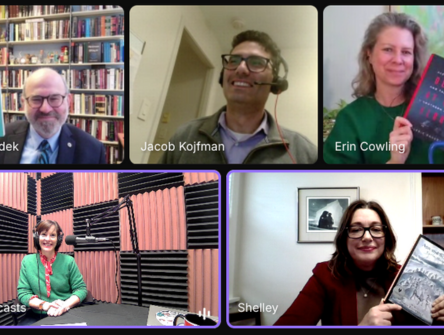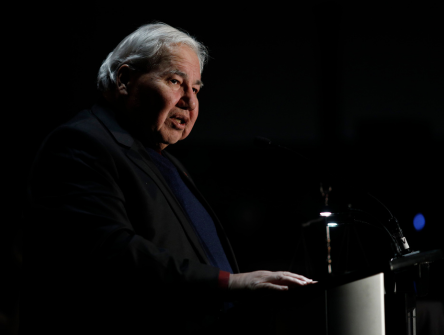Art lawyer
National interviews UBC Law professor Robert Paterson on a niche practice area: the recovery and protection of stolen or lost art.

National: How did you develop an interest in the study of art law?
Robert Paterson: I have taught a cultural property law course for about 22 years now. And my initial focus was more on law of corporations and securities regulations and international trade law. But I started getting interested in cultural property law in the late 80s, early 90s because I met people, not in Canada, but in Australia and in the United States, like John Merryman at Stanford who is a pioneer in this field, teaching and writing about it.
N: Are there many others interested in this area of study?
RP: It’s a very specialized legal discipline. And I think there’d be a few lawyers who would say “Well I’m an intellectual property lawyer and do a bit of work related to artistic and literary creations,” you know, or, “I’m a tax lawyer and I do a bit of work in charitable donations of cultural property.” But as an academic, I have the luxury of being able to look at the many sources of this law and try and bring it all together. It’s a little like environmental law, which started as a discipline in the 70s, when there weren’t environmental law statutes. There are still lots of sceptics about whether there is a field that you could call cultural property and art law at this stage.
N: What about outside Canada?
RP: There are lawyers in London and New York who probably do nothing but. They have major museums, which have issues about title. There have been several cases in New York alone involving claims related to the Holocaust. There are issues involving lending by museums, and there have been claims by countries like Turkey against museums, particular in the U.S., for returning objects that they claimed have been looted.
And in London and New York obviously, you have the big auction houses – Sotheby’s and Christie’s. So there’s just an enormous amount of material on the ground. And so that tends to create work for lawyers. To handle insurance problems, intellectual property problems, taxation problems. And we just don’t have it in Canada – on that scale anyway.
N: And yet you study the recovery of stolen or lost art.
RP: Yes. I’m interested in repatriation of Holocaust material and illegal looting of sites and smuggling of artefacts into markets, states and things of that kind. But in Canada, the main issue surrounds protection of intangible cultural heritage. Aboriginal culture issues are probably at the top of this pyramid. So I’ve worked with Cathy Bell at the University of Alberta on those kinds of issues and there are a lot of other people that tend to focus just on Aboriginal cultural issues. […] The renaissance of Aboriginal culture in Canada has made Aboriginal people more aware and assertive of their cultural rights. But those decisions about culture have tended to be subsumed under resource and land claims which are obviously of more pressing significance on a daily basis
N: How do you see this practice area evolving in the years ahead?
RP: I think it will continue to evolve mostly outside the courts. Artists and art lovers tend to avoid disputes that might end up in court. They are proud of the value of their collections, but somehow the value is more intrinsic and cultural than purely monetary. And so they are generally more averse to undue confrontation. They’d rather end these disputes amicably by a negotiated solution.
A lot of the Holocaust claims, particularly in the United Kingdom have been settled. There’s a panel in the United Kingdom, the Spoliation Advisory Panel, that’s headed by a former judge but is made up mostly of non-lawyers and that hears Holocaust claims and makes decisions. But they’re not binding on museums or governments, even though they are often implemented because of the thought and the consideration that’s gone into them.
N: Looking at the world today, what gives you cause for concern about the protection of art and culture?
RP: Obviously the most pressing and immediate concerns involve social unrest and armed conflict. Just recently the Islamic Museum in Cairo and the Library of Egypt were significantly damaged by a bomb. And before that, there had been significant losses in Afghanistan and Iraq. Armed conflict is really the most immediate and, in some ways, the most desperate situation because it’s usually impossible in those situations for anyone to go in and do anything about it at the time it’s happening. The damage is usually done before it can be stopped. I’m the rapporteur of the International Law Association’s cultural heritage law committee, and a few years ago we drafted some guidelines on what are called safe havens. This is a situation where someone sweeps in and rescues objects of a museum that is in physical danger and takes them away. It’s happened between Afghanistan and Switzerland. And we wanted to lay down some protocols for the state that had these objects temporarily in its custody. These are still informal, non-binding principles, but they’re an attempt to resolve what seems almost a unresolvable sort of situation.
N: Where does heritage conservation fit in to this discussion?
RP: It’s interesting. I’ve talked about the physical threats and harm to cultural heritage. But there are all sorts of passive ways in which cultural heritage is degraded and destroyed. In Vancouver for example the city has had enormous growth over the years, and there’s been a tremendous loss here on a very drawn out basis of heritage buildings and heritage homes. I mean there’s a struggle going on now to save the modernist home in West Vancouver of the BC painter Bertram Binning. Land prices here have gone through the roof. And so the older uses of the land for one-storey buildings seem inefficient and inappropriate. And there’s a conflict between the pressures of development and population growth on the one hand, and the rather muted and inevitably somewhat weaker pressures from conservationists and heritage advocates on the other.
It’s really one of the most difficult issues in the heritage conversation. In a way it’s similar to the issues surrounding Aboriginal culture because there’s a point at which conservation almost becomes anti-creative. If you reify things too much they lose the energy and the appeal that led to their being created in the first place. So it’s maintaining that delicate balance that I think you latch onto. It’s problematic. I’m not sure it’s something that laws can engineer. Maybe it’s just ultimately a series of political choices that need to be made.
This interview was edited and condensed for publication.


